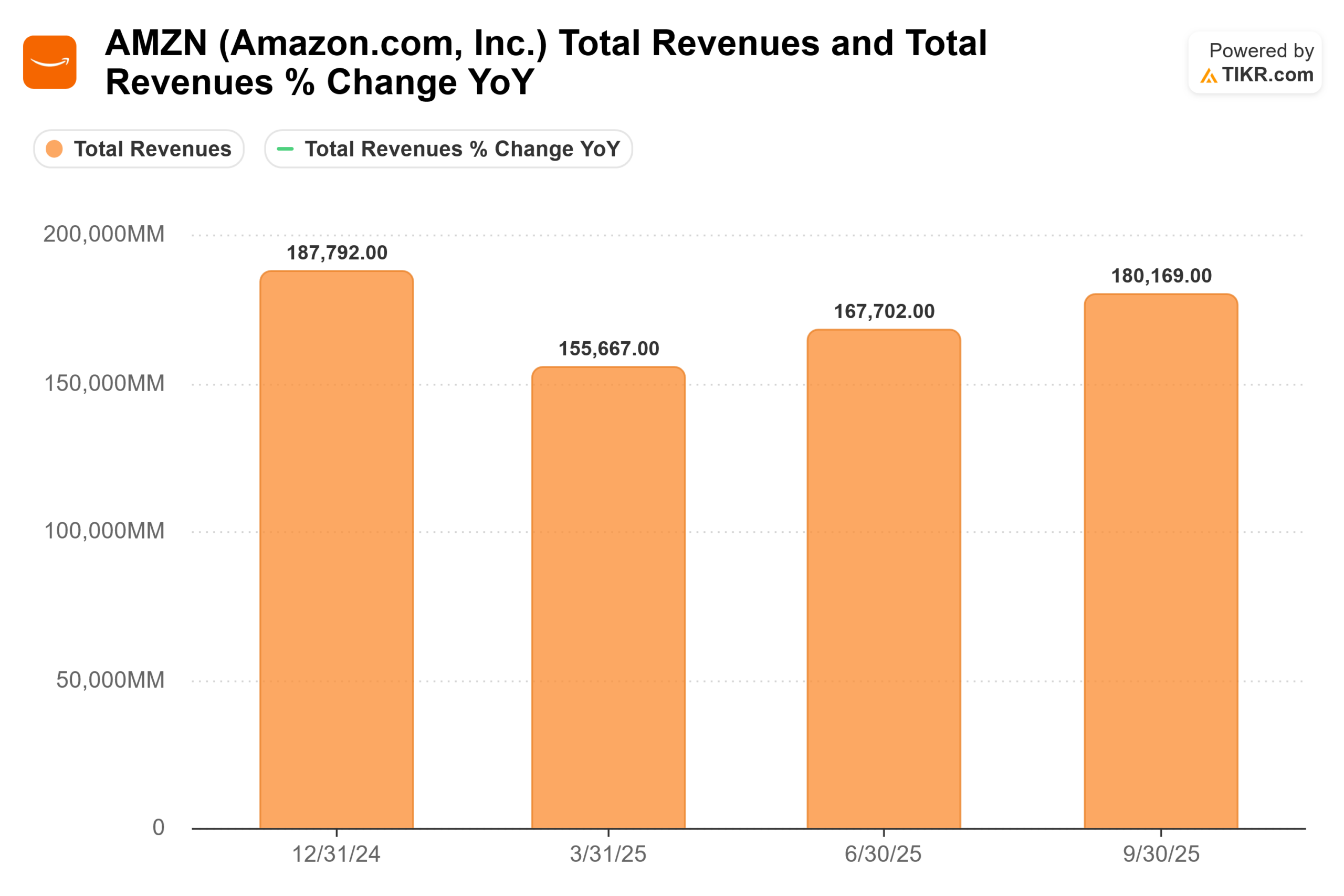Please note that we are not authorised to provide any investment advice. The content on this page is for information purposes only.
Amazon stock (NYSE: AMZN), which rose to a record high following its Q3 2025 earnings release, has come off all-time highs amid the sell-off in artificial intelligence (AI) stocks.
A section of the market, including leading fund managers, believes that AI stocks are currently in a bubble. The concern centers on whether the colossal investments being poured into AI infrastructure, such as the massive demand for Nvidia chips and new data centers, will ultimately translate into proportionally large profits and improved productivity, thus justifying the sky-high valuations.
Michael Burry Has Warned of an AI Bubble
Michael Burry, the investor made famous for correctly predicting and profiting from the 2008 US housing crisis, has issued a series of stark warnings about a potential AI investment bubble, arguing that the euphoria and massive capital spending are disconnected from sustainable economic reality.
Burry’s warnings are rooted in both historical market patterns and specific financial concerns regarding the massive AI build-out. He suggests these companies are extending the “useful life” of expensive AI hardware, such as Nvidia GPUs and data center equipment, from a typical 3-4 years to 5 or even 6 years on their balance sheets. Since depreciation is spread out over a longer period, this accounting change artificially understates operating expenses and, consequently, inflates reported short-term profits.
Tech Stocks Fall on AI Bubble Fears
He has also publicly criticized the revenue models in the AI sector, suggesting that “true end demand is ridiculously small.” Burry claims that a significant portion of AI customer growth is being funded by the very companies that are selling the AI services, creating a closed, self-reinforcing “money machine” instead of a sustainable, organic “flywheel” of demand. He has specifically cited investments between companies like Microsoft, OpenAI, Oracle, and Nvidia.
Burry points to the massive, rapid rise in US technology capex-to-GDP ratios, which he suggests are hitting levels last seen immediately before the Dot-Com Bubble and the 2008 Housing Crash.
Burry’s Scion Asset Management, which he has since deregistered, held significant put options in Q3, a form of bearish bet, against the stocks of key AI players, notably NVIDIA and Palantir, positioning for a correction in their highly valued shares.
Uncertainty Over Fed Rate Cut
Meanwhile, the sell-off in AI plays like Amazon has been compounded by mixed signals from economic data, particularly the jobs report, which has led to uncertainty over future Federal Reserve interest rate cuts. Higher-for-longer rate expectations tend to put downward pressure on the valuations of growth stocks, like those in the tech and AI sectors.
Amazon Is a Major AI Player
For Amazon, a major player in AI primarily through its Amazon Web Services (AWS) cloud unit, the stock drop has been influenced by both sector-wide concerns and company-specific issues.
Analysts have raised concerns that the economics of the new generative AI era are “destructive” compared to the initial “Cloud 1.0” boom. Specifically, it’s argued that AI infrastructure requires significantly more capital (up to six times more by some estimates) to generate the same economic value as traditional cloud investments. This suggests a potential decline in the return on investment for Amazon’s large-scale AI spending.
Amazon Raised Its 2025 Capex Guidance
Amazon’s heavy capex, expected to reach around $125 billion for the year, is under intense scrutiny. This spending, largely directed toward AI and cloud infrastructure, was recently highlighted by Amazon’s debt offering to raise $15 billion, which was the company’s first issuance in three years. This move confirmed the massive cost of the AI build-out, raising questions about future free cash flow and the financial returns on this heavy investment.
Meanwhile, during the Q3 earnings call, CEO Andy Jassy emphasized the impact of AI, stating that it is “driving meaningful improvements in every corner of our business,” particularly in Amazon Web Services (AWS). The company is aggressively investing in AI infrastructure, including its custom Trainium chips, and expanding its data center capacity. This investment focus contributed to a sharp decline in trailing twelve-month free cash flow to $14.8 billion, primarily due to a substantial increase in capital expenditures.


Amazon Reported Strong Growth in Q3
Amazon had a strong Q3, with sales rising 13% year-over-year to $180.2 billion, marking a 13% increase year-over-year, or 12% excluding the favorable impact of foreign exchange rates. This figure surpassed the consensus forecast of $177.8 billion from Wall Street analysts.
Net Income rose to $21.2 billion, translating to $1.95 per diluted share, handily beating estimates of $1.57. However, this figure was substantially boosted by a $9.5 billion pre-tax gain from Amazon’s investment in AI startup, Anthropic, which is categorized as non-operating income.
Amazon’s operating income came in at $17.4 billion. This figure was weighed down by two substantial special charges totaling $4.3 billion. These include a $2.5 billion legal settlement with the Federal Trade Commission (FTC) and $1.8 billion in estimated severance costs primarily related to planned role eliminations. Excluding these one-time charges, operating income would have been a stronger $21.7 billion.
For the fourth quarter, which includes the holiday shopping season, Amazon provided an optimistic outlook. It expects net sales to be in the range of $206 billion to $213 billion, whose midpoint was ahead of Street estimates. The company expects Q4 operating Income to be between $21 billion and $26 billion, versus the consensus estimate of $23.8 billion.
AWS Is Witnessing Growth Due to AI
AWS’s operating income also saw a healthy increase, reaching $11.4 billion, up from $10.4 billion in the third quarter of 2024. This growth came despite significant, ongoing capital expenditures directed primarily toward building out the necessary infrastructure to meet booming demand, especially for AI-related workloads.
The re-acceleration was overwhelmingly attributed to surging customer interest and spending on AI. Customers continued to increase their consumption of cloud services, and the shift toward generative AI applications is beginning to translate into substantial revenue.
Commenting on AWS performance, Jassy said that the business is “growing at a pace we haven’t seen since 2022” while adding “We continue to see strong demand in AI and core infrastructure, and we’ve been focused on accelerating capacity — adding more than 3.8 gigawatts in the past 12 months.”
All said, the positive momentum in Amazon has lost steam amid the AI sell-off, with Burry’s dire warnings only dampening sentiments.
#Amazon #Stock #Falls #Record #Highs #SellOff


